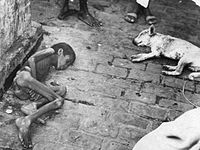
Photo from wikipedia
OBJECTIVE to analyze the occurrence of food insecurity and associated factors in Rio Grande, Rio Grande do Sul, Brazil, in 2016. METHODS this was a cross-sectional population-based study using data… Click to show full abstract
OBJECTIVE to analyze the occurrence of food insecurity and associated factors in Rio Grande, Rio Grande do Sul, Brazil, in 2016. METHODS this was a cross-sectional population-based study using data obtained by interviewing heads of household; Poisson regression with robust variance adjustment was used. RESULTS 675 households were included; food insecurity prevalence was 35.2% (95%CI31.6;39.0) and its occurrence was associated with heads of household being female (PR=1.49 - 95%CI1.17;1.90), not being white-skinned (PR=1.49 - 95%CI1.18;1.88), being younger, unmarried (PR=1.39 - 95%CI 1.07;1.81), belonging to the lowest education bracket (PR=1.58; 95%CI 1.17;2,12), belonging to the first and second assets index tertiles, having insufficient money to meet expenses (PR=2.22 - 95%CI 1.76;2.80), being obese (PR=1.39 - 95%CI 1.13;1.71), and being a smoker (PR=1.28 - 95%CI 1.05;1.56). CONCLUSION food insecurity was associated with all factors studied except alcohol abuse.
Journal Title: Epidemiologia e servicos de saude : revista do Sistema Unico de Saude do Brasil
Year Published: 2020
Link to full text (if available)
Share on Social Media: Sign Up to like & get
recommendations!